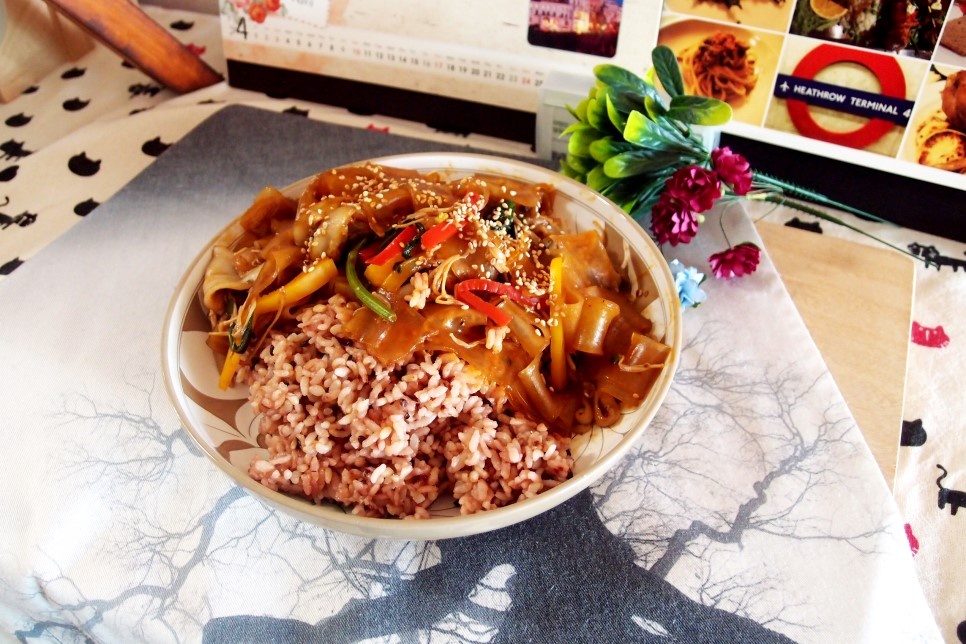Spicy & Savory Yangjangpi Japchae Rice Bowl with Oyster Sauce
#MakeYangjangpiJapchaeRiceBowl with Oyster Sauce and Chili Oil Sauce #EnjoyYangjangpiJapchae as a Rice Bowl Instead of Traditional Japchae!

This is a Yangjangpi Japchae Rice Bowl made with a spicy and savory oyster sauce and chili oil sauce. Enjoy this unique dish with rice! It’s a delightful twist on the typical Chinese restaurant’s ‘Japchae Rice’, offering a fusion of textures and flavors. The combination of tender Yangjangpi, fresh vegetables, and your choice of protein creates a wonderfully satisfying meal.
Main Ingredients- 1 bundle Yangjangpi (Korean cellophane noodles)
- 1/2 bell pepper, julienned
- 1 bowl seafood (scallops, squid, shrimp, etc.)
- 1 enoki mushroom, trimmed
- 1/2 bunch crown daisy (or substitute with other leafy greens)
- 2 servings cooked rice
Cooking Instructions
Step 1
First, soak the Yangjangpi in lukewarm water for about 10 minutes until it becomes soft and pliable. Then, blanch it in boiling water for just 30 seconds to 1 minute. Immediately rinse under cold water and drain well. This prevents the noodles from becoming mushy or clumping.

Step 2
Julienne the bell pepper. Trim the base of the enoki mushrooms and separate them into strands. Wash the crown daisy thoroughly and pat dry. Feel free to use other vegetables you have on hand, such as onions, carrots, or shiitake mushrooms. Slicing all vegetables into similar sizes will make cooking easier.

Step 3
Heat a pan over high heat and add the chili oil sauce. Add the sliced garlic and chopped green onions. Stir-fry for about 1 minute until fragrant, being careful not to burn the garlic. This creates a flavorful base for the dish.

Step 4
Once the chili oil and green onion aroma is released, carefully pour the cooking wine (or mirin) around the edges of the pan. Let the alcohol evaporate, which adds a wonderful ‘wok hei’ (breath of the wok) flavor. Then, add the soy sauce in the same way and stir-fry everything together. Cooking on high heat is key for developing that smoky wok flavor.

Step 5
Now, add the sugar and stir-fry until it dissolves. The caramelizing sugar will further enhance the wok hei and add a subtle sweetness, deepening the overall flavor profile.

Step 6
Add your chosen seafood (e.g., scallops, squid, shrimp) to the pan and cook until it’s almost done. Be careful not to overcook delicate seafood like scallops. If using thinly sliced pork for japchae, stir-fry the pork first until cooked through before adding other ingredients. A mix of frozen seafood is also a great option.

Step 7
When the seafood is nearly cooked, add all the prepared vegetables (bell pepper, enoki mushrooms, crown daisy, etc.) to the pan. Stir-fry briskly over high heat for about 2-3 minutes, ensuring the chili oil sauce coats all the ingredients. It’s important to maintain a slight crispness in the vegetables.

Step 8
At this stage, the dish is not yet seasoned. Add a pinch of black pepper for extra aroma. The Yangjangpi will be added next, so hold off on the final seasoning for a moment.

Step 9
Add the soaked and blanched Yangjangpi, which has been drained of excess water. Gently toss and stir-fry with the other ingredients for about 1 minute, ensuring the noodles are well combined and coated with the sauce.

Step 10
Now it’s time for the final seasoning. Add the oyster sauce to taste. It provides a good balance of savory and slightly sweet notes. For an extra boost of umami, consider adding a little XO sauce (optional). Stir well and taste, adjusting the seasoning as needed.

Step 11
Once all ingredients are well-coated in the sauce and have developed a delicious brown hue, turn off the heat. Drizzle with sesame oil and gently toss to finish. If you prefer a saucier, gravy-like consistency for a rice bowl, you can add a little water at this point, bring it to a simmer, and then thicken with a cornstarch slurry. However, keep in mind that Yangjangpi can absorb liquid and become softer, so adjust the consistency accordingly.

Step 12
Serve the delicious Yangjangpi Japchae generously over a bowl of warm rice. Sprinkle with toasted sesame seeds for a final touch. Enjoy your homemade restaurant-style Yangjangpi Japchae Rice Bowl!




